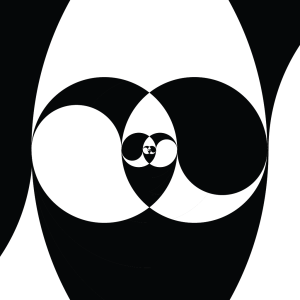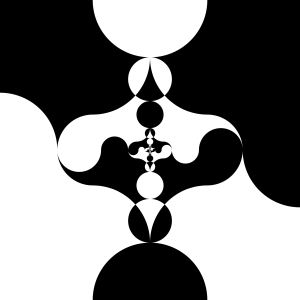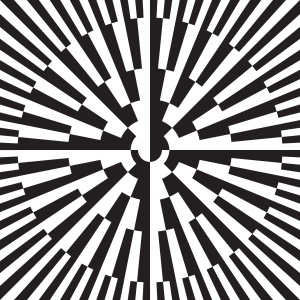Birds Over Babel
On the imminent transformation of intelligence.

The accelerating evolution of digital computing and Artificial Intelligence is on the cusp of a fundamental and all-encompassing transformation. Visions of endless datacenters, fears of permanent robo-dictatorships, and fantasies of “mind-uploading” miss the larger context and potentials of this process. Rather than an unlimited acceleration toward disembodied escapism, the development of digital computation (through AI) are actually coming full circle to converge upon the analog structure of living organisms and ecosystems, and ultimately the innate “siddhic”1 capabilities of the undistorted body-mind.
Fundamentally, computation is the purposeful transformation of information. A sequence of bits, 1s and 0s, is called a “word”. In digital computing these “words” have no intrinsic meaning; their significance is entirely mediated by the software context2. In contrast, generative AI works with geometric representations in latent space (lower-dimensional crystallizations of higher-dimensional structures); for example, the “parameters” of a language model which distill a matrix of semantic relationships from a vast corpus of training data. There is an underlying structure to the computation which is increasingly generalized.
The structure of traditional digital computers can simulate these emerging higher-dimensional structures but at great expense – like modeling a wave by representing every molecule of water. Yet these kinds of trans-contextual representations could be implemented in complex physical substrates, through an analog computing paradigm called reservoir computing.
The technological trajectory must play out its course. We needed to externalize intelligence in order to recognize the subtle intelligence of life, which had been overlooked from a disembodied perspective. The intense expansion of digital infrastructure is bringing analog living computing closer, not further — the crunchy yet crucial detour of bridging the explicit and the implicit. Leviathan data centers are a transitional stage, a chrysalis, that leads to far more agile devices that become trivially simple to produce until the computer becomes the ecosystem itself. The tower of Babel powers toward heaven, yet birds simply fly overhead.
Modern computing assumes a continuous exponential increase in power over time. The most well-known description of this is “Moore’s Law”, the approximate doubling of microchip complexity (i.e. transistor density) every 2 years for the past 60 years. Yet this process has come to an end with transistors a single atom thick, at the edge of quantum indeterminacy where 1 and 0 cannot be separated. Other avenues for scaling computational power, such as increasing clock speed, have also reached their limit.
Yet like a dammed river, or economies dependent on continuous “growth”, the vast momentum of tech development (some $10,000,000,000,000 a year) will carve new outlets. It will do so by revisiting the fundamental architecture of modern computers, and considering what other possibilities are now available, especially as the explosion of AI carries unprecedented demands for computing power.
One such development is memristors (substances that combine “memory” and “processing” capabilities). Another is reservoir computing3 using complex physical substrates. Another is the intensive research into quantum computing.
These are all properties of living protoplasm – including the elusive “wet & warm” quantum coherence4. The ideal computing substrate for the development of so-called “artificial” intelligence turns out to be living organization itself, which in hindsight was simply waiting for the computational paradigm to catch up. This insight overturns the reductionist “bioinformatic” gaze that attempts to contain living complexity within digital models and refers to the irreducible complexity of life as mere “noise”. The insatiable skepticism that emerges from the disembodied perspective cannot see its own blindness and clearcuts the forest for the trees.
Embodied computation reflects embodied intelligence. The transition is not just a matter of building more elaborate machines, but of cultivating a quality of awareness. $10 trillion is spent on external tech; what is the state of “inner technology”?
The near future of computing will be analog — and it will be both unlike anything that existed before and also exactly what has been here all along.
“Siddhi” is a term from the yogic tradition referring to extraordinary capabilities that emerge from internal cultivation. Often described as supernatural or magical, they represent the latent potential of unbound consciousness.
In universal semiotic systems such as the I Ching, Ilm Al-Raml, or IFA, each “word” represents a universal archetype, applicable on all scales and contexts. For example, in the I Ching, ䷀ (111111) is The Creative, while ䷁ (000000) is The Receptive. Geomancy uses 4 bit words, the I Ching uses 6 bit words, and IFA uses 8 bit words. Each of these systems is used as a kind of cultural semiotic index — symmetrical, scale-free, and consistent — and it’s not hard to imagine this process extended ad infinitum as a means of encoding universal language. In fact, the Fu Xi (digital) sequence of the I Ching was the direct inspiration for the first binary system published in Europe, the distant ancestor of modern computers.


Reservoir (or “in materia”) computing is a universal analog computing paradigm that sends an input into a complex medium and trains an output layer to extract relevant information. One familiar example is echolocation – a tone is emitted, and meaningful information is extracted from the reflected sound. Another is a bucket of water used to perform complex calculations back in 2003 – by measuring the waves on its surface in response to specific inputs, differential equations can be solved “by the water” that would require substantial digital computing power to simulate. Unlike traditional digital computing which is explicit and bounded, reservoir computing is implicit and boundless; any input can be used, and any output can be extracted.











